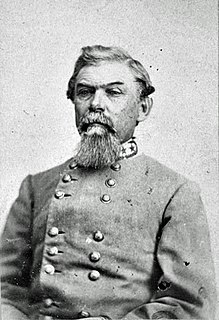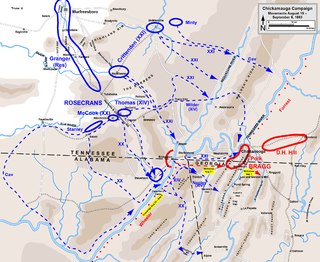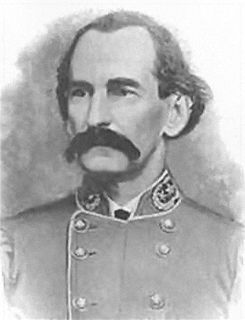| 6th Kentucky Infantry Regiment | |
|---|---|
| Active | November 19, 1861 – May 7, 1865 |
| Country | Confederate States of America |
| Branch | Confederate States Army |
| Type | Infantry & Mounted Infantry |
| Engagements | Battle of Shiloh Battle of Baton Rouge Battle of Stones River Defense of Vicksburg Siege of Jackson Battle of Chickamauga Atlanta Campaign Battle of Ringgold Gap Battle of Resaca Battle of Dallas Battle of Kennesaw Mountain Battle of Peachtree Creek Battle of Atlanta Battle of Jonesboro Sherman's March to the Sea |
The 6th Kentucky Infantry Regiment was an infantry regiment that served in the Confederate States Army during the American Civil War. It was formed from Nelson, Barren, and surrounding counties. It was also part of the First Kentucky Brigade.
The 6th Kentucky Infantry was organized November 19, 1861, at Bowling Green, Kentucky and mustered in under the command of Colonel Joseph Horace Lewis.
At the Battle of Shiloh, the regiment was brigaded with the 4th Alabama Infantry, 31st Alabama Infantry, 3rd Kentucky Infantry, 4th Kentucky Infantry, and 9th Kentucky Infantry. The regiment retreated to Corinth, Mississippi, after the battle and was ordered to Vicksburg, Mississippi, to aid in the defenses there.
The regiment remained at Port Hudson, Louisiana, until August 20, 1862, when it was ordered to Jackson, Mississippi. Later, Maj. Gen. John C. Breckinridge was ordered to take the 4th Kentucky Infantry, 6th Kentucky Infantry, and 9th Kentucky Infantry with him and report to Gen. Braxton Bragg.
The regiment came under heavy fire at the Battle of Stones River on January 2, 1863. Having been ordered by Bragg to attack an area that division commander Maj. Gen. Breckinridge had reconnoitered and determined to be too heavily defended, the First Kentucky Brigade led the charge. Although initially successful, the brigade was met by heavy Union Army artillery fire. In which the brigade lost 51% of those that were active in the charge. Brigade commander Brig. Gen. Roger Hanson was also mortally wounded in the attack.
Later that same year, the First Kentucky Brigade was ordered back to Vicksburg, to help relieve the siege. The brigade arrived after the fall of Vicksburg on July 4, 1863, and fell back to Jackson, Mississippi, where they were attacked in mid-July. At the Battle of Chickamauga the 4th Kentucky Infantry and 6th Kentucky Infantry charged a part of the federal line, defended by the 15th Kentucky Infantry and Bridges' Illinois Battery. The two regiments routed the infantry and captured two cannons, turning them on the fleeing enemy. Weeks later, the 6th Kentucky Infantry was called upon to guard the Confederate army's retreat following the Battle of Missionary Ridge. The army retreated to Dalton, Georgia and went into winter quarters.
The First Kentucky Brigade became part of the Atlanta Campaign on May 7, 1864, when they left their winter camps at Dalton, Georgia and took up positions on Rocky Face Ridge. The regiment became part of the fighting retreating force as Maj. Gen. William T. Sherman pushed the Confederates further back toward Atlanta. At the Battle of Dallas near New Hope Church, the First Kentucky Brigade made an unsupported charge, losing 51% of its strength. At the Battle of Jonesboro on August 31, 1864, the brigade was ordered to attack the entrenched federal position. At an unseen deep ravine, the attack came to a halt. The following day, the Confederates were overwhelmed when two-thirds of a Union Army division attacked and began to surround their positions. Many of the men of the 2nd Kentucky Infantry, 6th Kentucky Infantry, and 9th Kentucky Infantry were captured. The remnants of the brigade fell back and managed a successful defense against the Union assault, bringing it to a halt. On September 4, only 500 men were present for duty in the entire First Kentucky Brigade. That same month, the regiment was converted to mounted infantry at Griffin, Georgia.
The regiment was engaged in delaying tactics during Sherman's March to the Sea, following him all the way to Savannah, Georgia, finally moving to Augusta, Georgia, in early 1865. The regiment's last engagement was on April 29, 1865, in a skirmish near Stateburg, South Carolina. The regiment was ordered to Washington, Georgia and surrendered on May 7, 1865.

The Battle of Chickamauga, fought on September 18 – 20, 1863, between U.S. and Confederate forces in the American Civil War, marked the end of a Union offensive, the Chickamauga Campaign, in southeastern Tennessee and northwestern Georgia. It was the first major battle of the war fought in Georgia, the most significant Union defeat in the Western Theater, and involved the second-highest number of casualties after the Battle of Gettysburg.

The Battle of Stones River was a battle fought from December 31, 1862, to January 2, 1863, in Middle Tennessee, as the culmination of the Stones River Campaign in the Western Theater of the American Civil War. Of the major battles of the war, Stones River had the highest percentage of casualties on both sides. Although the battle itself was inconclusive, the Union Army's repulse of two Confederate attacks and the subsequent Confederate withdrawal were a much-needed boost to Union morale after the defeat at the Battle of Fredericksburg, and it dashed Confederate aspirations for control of Middle Tennessee.

William Joseph Hardee was a career U.S. Army and Confederate States Army officer. For the U.S. Army, he served in the Second Seminole War and in the Mexican–American War, where he was captured and exchanged. In the American Civil War, he sided with the South and became a general. Hardee served in the Western Theater and quarreled sharply with two of his commanding officers, Braxton Bragg and John Bell Hood. He served in the Atlanta Campaign of 1864 and the Carolinas Campaign of 1865, where he surrendered with General Joseph E. Johnston to William Tecumseh Sherman in April. Hardee's writings about military tactics were widely used on both sides in the conflict.

The Battle of Missionary Ridge was fought on November 25, 1863, as part of the Chattanooga Campaign of the American Civil War. Following the Union victory in the Battle of Lookout Mountain on November 24, Union forces in the Military Division of the Mississippi under Maj. Gen. Ulysses S. Grant assaulted Missionary Ridge and defeated the Confederate Army of Tennessee, commanded by Gen. Braxton Bragg, forcing it to retreat to Georgia.

The Tullahoma campaign was a military operation conducted from June 24 to July 3, 1863, by the Union Army of the Cumberland under Maj. Gen. William Rosecrans, and regarded as one of the most brilliant maneuvers of the American Civil War. Its effect was to drive the Confederates out of Middle Tennessee and to threaten the strategic city of Chattanooga.

The Chickamauga campaign of the American Civil War was a series of battles fought in northwestern Georgia from August 21 to September 20, 1863, between the Union Army of the Cumberland and Confederate Army of Tennessee. The campaign started successfully for Union commander William S. Rosecrans, with the Union army occupying the vital city of Chattanooga and forcing the Confederates to retreat into northern Georgia. But a Confederate attack at the Battle of Chickamauga forced Rosecrans to retreat back into Chattanooga and allowed the Confederates to lay siege to the Union forces.

The siege of Corinth was an American Civil War engagement lasting from April 29 to May 30, 1862, in Corinth, Mississippi. A collection of Union forces under the overall command of Major General Henry Halleck engaged in a month-long siege of the city, whose Confederate occupants were commanded by General P.G.T. Beauregard. The siege resulted in the capture of the town by Federal forces.

The Western Theater of the American Civil War encompassed major military operations in the states of Alabama, Georgia, Florida, Mississippi, North Carolina, Kentucky, South Carolina and Tennessee, as well as Louisiana east of the Mississippi River. Operations on the coasts of these states, except for Mobile Bay, are considered part of the Lower Seaboard Theater. Most other operations east of the Mississippi are part of the Eastern Theater. Operations west of the Mississippi River took place in the Trans-Mississippi Theater.

The Orphan Brigade was the nickname of the First Kentucky Brigade, a group of military units recruited from Kentucky to fight for the Confederate States of America during the American Civil War. The brigade was the largest Confederate unit to be recruited from Kentucky during the war. Its original commander was John C. Breckinridge, former United States Vice President and candidate for president, who was enormously popular with Kentuckians.

The Battle of Baton Rouge was a ground and naval battle in the American Civil War fought in East Baton Rouge Parish, Louisiana, on August 5, 1862. The Union victory halted Confederate attempts to recapture the capital city of Louisiana.
The 19th Tennessee Infantry Regiment, or Nineteenth Tennessee Volunteer Infantry Regiment, was an infantry regiment in the Confederate States Army during the American Civil War. The 19th Tennessee fought in every major battle and campaign of the Army of Tennessee except the Battle of Perryville. First Lieutenant Robert D. Powell of Company K, killed at the Battle of Barbourville, Kentucky, is believed to be the first soldier killed during the Civil War in that state.

Marcellus Augustus Stovall was an American soldier and merchant. He served as a Confederate general during the American Civil War, and later he resumed business and civil interests.

The Chattanooga campaign was a series of maneuvers and battles in October and November 1863, during the American Civil War. Following the defeat of Maj. Gen. William S. Rosecrans's Union Army of the Cumberland at the Battle of Chickamauga in September, the Confederate Army of Tennessee under Gen. Braxton Bragg besieged Rosecrans and his men by occupying key high terrain around Chattanooga, Tennessee. Maj. Gen. Ulysses S. Grant was given command of Union forces in the West, now consolidated under the Division of the Mississippi. Significant reinforcements also began to arrive with him in Chattanooga from Mississippi and the Eastern Theater. On October 18, Grant removed Rosecrans from command of the Army of the Cumberland and replaced him with Major General George Henry Thomas.

John King Jackson was an American lawyer and soldier. He served as a Confederate general during the American Civil War, mainly in Florida and the Western Theater of the conflict. Afterward Jackson resumed his law practice until dying from pneumonia a year after the war ended.
The 3rd Kentucky Infantry Regiment was a volunteer infantry regiment that served in the Confederate States Army during the American Civil War. It was part of the First Kentucky Brigade through August 1862.

The 4th Kentucky Infantry Regiment was an infantry regiment that served in the Confederate States Army during the American Civil War. It was part of the First Kentucky Brigade.
The 5th Kentucky Infantry Regiment was an infantry regiment that served in the Confederate States Army during the American Civil War. In 1863 it became part of the First Kentucky Brigade.
The 7th Kentucky Infantry Regiment was an infantry regiment that served in the Confederate States Army during the American Civil War.
The 9th Kentucky Infantry Regiment was an infantry regiment that served in the Confederate States Army during the American Civil War. It was part of the First Kentucky Brigade.

The 9th Arkansas Infantry was a Confederate Army infantry regiment during the American Civil War. It served throughout the war in the western theater, seeing action in the Vicksburg, Tennessee and Georgia campaigns. Following its depletion in numbers the regiment was consolidated several times with other Arkansas regiments, finally merging in 1865 into the 1st Arkansas Consolidated Mounted Rifles.